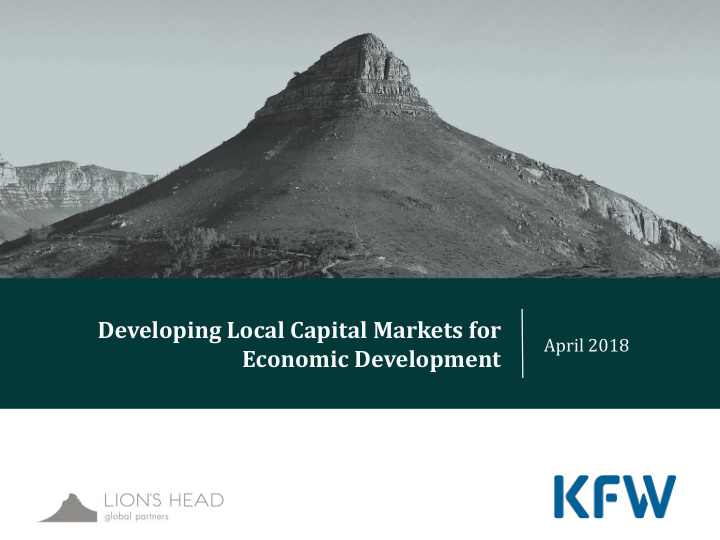



Developing Local Capital Markets for April 2018 Economic Development
CONTENTS INTRODUCTION LHGP: Firm Overview ▪ LHGP: Senior Management ▪ CHARACTERISTICS OF DEVELOPING CAPITAL MARKETS Capital Market Ecosystem ▪ ▪ Multi-causality in the Capital Market Ecosystem ▪ Clustering of Capital Markets INTERVENTIONS FOR CAPITAL MARKET DEVELOPMENT Market Characteristics And Interventions ▪ ▪ Types of Interventions ▪ Mapping of Potential Interventions Lessons from Donors ▪ 2
INTRODUCTION
LION’S HEAD GLOBAL PARTNERS 1 Firm Overview Lion’s Head was established in 2008 and provides clients with state-of-the-art advisory and ▪ execution capacity plus the means to reach major pools of international capital. ▪ Lion’s Head’s business is built on three core pillars – strategic advisory, financial structuring and fund management. Through them, LGHP brings capital markets expertise to development finance, leading “first -of-their- kind” transactions across Africa and other frontier markets. LHGP has been the Fund Manager for the Africa Local Currency Bond Fund (ALCBF) since 2015, and ▪ is currently structuring the Off Grid Energy Access Fund (OGEF) which it will manage for AfDB. STRATEGIC ADVISORY FINANCIAL STRUCTURING FUND MANAGEMENT countries of LHGP experience 4
LION’S HEAD GLOBAL PARTNERS 2 Senior Management Christopher Egerton-Warburton “Edge” (Partner) Edge is an expert in the structuring and execution of innovative financing solutions. He was formerly the Head of the Sovereign, Supranational and Agency Group at Goldman Sachs. Edge has significant experience in fundraising for public-private financing initiatives such as GAVI. He was the lead banker on the design and execution of the International Finance Facility for Immunisation (IFFIm). Clemens Calice (Partner) Clemens is a Partner at Lion’s Head and manages the Nairobi office, following senior roles at Goldman Sachs and Morgan Stanley where he worked as an investment banker for over 15 years. Clemens is the Chief Investment Officer of the ALCBF and has engaged in a number of capital market development initiatives in Africa through setting up vehicles and structuring first-of-a-kind transactions. Alan Follmar (Managing Director) Alan joined LHGP as Managing Director and Chief Operating Officer in 2018. He has 17 years of emerging market finance experience with a focus on power, infrastructure and public-private partnerships. Alan previously held senior positions at Meridiam Africa, Proparco, Natixis and Barclays Capital. In 2016, he established the strategy and fully operationalised the European Commision’s ElectriFI programme. 5
CHARACTERISTICS OF DEVELOPING CAPITAL MARKETS
CHARACTERISTICS OF DEVELOPING CAPITAL MARKETS 4 Capital Market Ecosystem 7
CHARACTERISTICS OF DEVELOPING CAPITAL MARKETS CIRCULAR AND 5 Multi-causality in the Capital Market Ecosystem • Issuers and Investors can interact directly, or through intermediaries, such as mutual funds, banks or brokers. In an ecosystem, the same actor can play multiple roles: banks can act as issuers, investors and intermediaries. Capital market ecosystems are circular and multi-causal in nature: developing one element can • have a positive effect on others. Conversely, problems are generally multi-causal which makes it difficult to solve a specific problem through a single targeted initiative only. 8
CHARACTERISTICS OF DEVELOPING CAPITAL MARKETS CIRCULAR AND 6 Clustering of Capital Markets Capital Market Interventions must be adapted to the Level of Market Development • The challenge of capital market development is how to bring a market from a lower • to a higher tier 9
CHARACTERISTICS OF DEVELOPING CAPITAL MARKETS CIRCULAR AND 7 Clustering of Capital Markets 10
CHARACTERISTICS OF DEVELOPING CAPITAL MARKETS CIRCULAR AND 8 Clustering of Capital Markets 11
INTERVENTIONS FOR CAPITAL MARKET DEVELOPMENT
CHARACTERISTICS OF DEVELOPING CAPITAL MARKETS CAPITAL 9 Market Characteristics And Interventions 13
CHARACTERISTICS OF DEVELOPING CAPITAL MARKETS CAPITAL 10 Types of Interventions The three types of Capital Market Interventions are Capacity Building, Product-based and Vehicle- based interventions ▪ Capacity Building Interventions can be financed through grants, concessional or commercial funds, and take the form of skill development at implementation level as well as support at the structural level i.e. strengthening of capital market regulatory framework or capital market infrastructure. Product-based Interventions can take two forms of support: ▪ (1) Products could be credit-enhanced by providing some form of a guarantee, or (2) Products could be supported through anchor investments signalling to the market that a serious investor has appetite for the asset. Vehicle-based Interventions are more than one-off transactions and have a more lasting effect on ▪ capital markets. Through tailored solutions, vehicles can address a wide range of challenges. Support can mainly be provided in two ways: (1)Enabling Support, which allows the vehicle to be set up. This can take the form of an anchor investment either through equity or debt, or in the case of a guarantee vehicle, a back-stop. (2)Facilitating Investment, meaning that sponsors facilitate investment from third parties by making the exposure to the vehicle more attractive. This may be in the form of a guarantee for investors or the vehicle’s portfolio, or provision of subordinated capital to the vehicle. 14
CHARACTERISTICS OF DEVELOPING CAPITAL MARKETS CAPITAL 11 Mapping of Investable Interventions 15
INTERVENTIONS FOR CAPITAL MARKET DEVELOPMENT 12 Lessons From Donors ▪ Capacity Building Interventions can take the form of skill development at implementation level as well as support at the policy and structural level i.e. strengthening of capital market regulatory frame-work or market infrastructure. The World Bank’s role as an honest broker in developing regulatory environment was more important than actual advice on transactions. ▪ More emphasis on local bond markets needed for countries that graduate IDA (IDA funding often corresponds to more than 20% of the local bond markets) and thus need to rely more on local sources of financing Combining capital market and wider financial sector reform increases impact compared to ▪ more targeted interventions (e.g. merging money market and bond issuance work) ▪ Pure focus on equity markets has not been successful, in particular when focused on SMEs ▪ Regulatory and product focused work needs to be tailored to the country context – risk to launch too sophisticated interventions 16
Recommend
More recommend